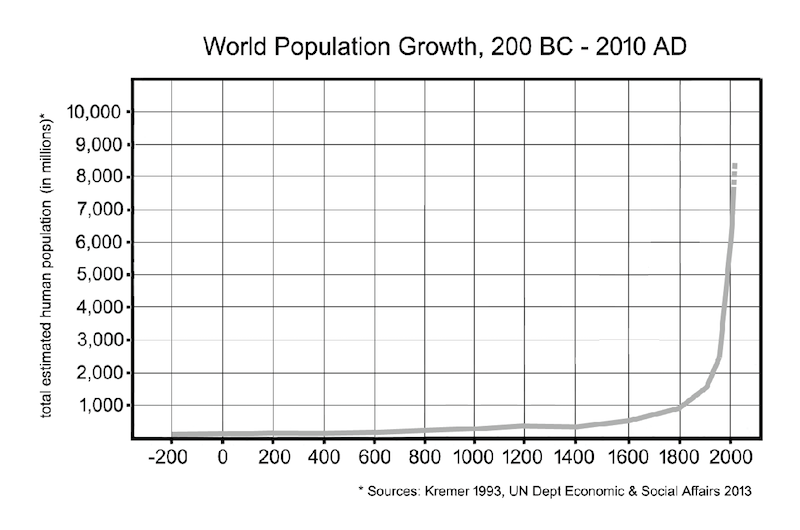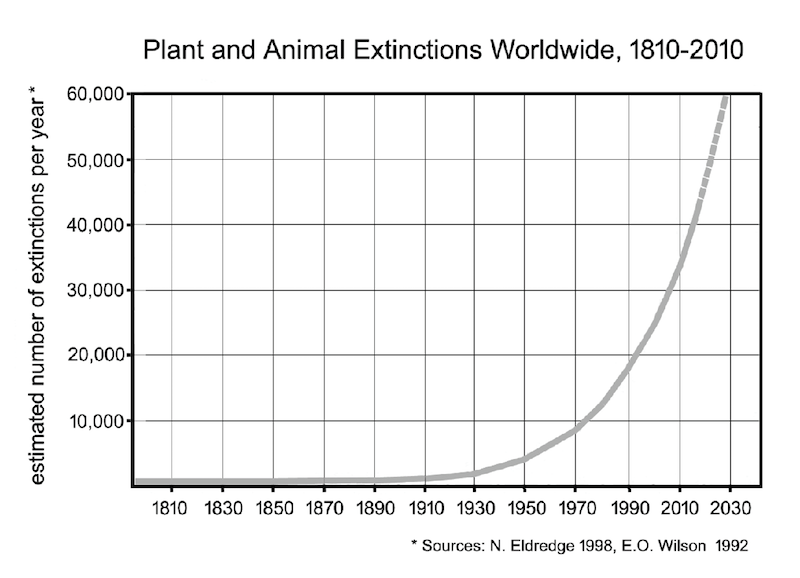Our World at the Brink
Episode #10 of the course Technologies that transformed humanity by Richard L. Currier, PhD
Humanity has now taken over the natural environment and is converting our planet into a vast production unit for its own exclusive benefit. The result is uncontrolled overpopulation and massive species extinction.
Overpopulation
During prehistoric times, the world’s human population never exceeded five million people. But as a result of agriculture and urban civilization, the population mushroomed to 150 million and quadrupled to 600 million by 1600 AD.

The human population has truly exploded during the past two hundred years.
But the industrial revolution caused the human population to truly explode, increasing from less than one billion to over six billion in the last 200 years. The human population is now increasing by 250,000 people every day.
The Sixth Mass Extinction
There have been five mass extinctions in geologic history. The causes of the first four extinctions is unclear, but the fifth was caused by an immense dust cloud that covered the earth when a gigantic asteroid slammed into the Gulf of Mexico, blocking out the sun for years. The resulting “global winter” killed off the dinosaurs and 75% of all life on earth.
| Extinction | Years Ago | Period | Characteristic Types of Life Forms |
| First | 445 million | Ordovician | Primitive marine creatures; trilobites and coral |
| Second | 360 million | Devonian | Early fishes and insects; land-based plants |
| Third | 250 million | Permian | Primitive reptiles |
| Fourth | 200 million | Triassic | Large amphibians and marine reptiles |
| Fifth | 65 million | Cretaceous | Dinosaurs; early birds and mammals |
Human activity—including overpopulation, pollution, deforestation, and the collapse of ecosystems—is now threatening a sixth mass extinction.

The number of species becoming extinct each year has been increasing dramatically since 1900.
Approximately 30,000 species are now becoming extinct every year, and it takes five to 15 million years for evolution to replace each extinct life form. Five million years ago, our ancestors were apes living in the trees. Five million years from now, humans will probably be extinct.
The Perils of Climate Change
Perhaps no environmental threat is more discussed nowadays than global warming caused by carbon dioxide emissions. Fossil fuels have already increased atmospheric carbon dioxide from 270 parts per million (ppm) to 400 ppm, but this is not the highest it has ever been. Two hundred million years ago, atmospheric carbon dioxide peaked at 2,500 ppm.
On the flip side, several ice ages have occurred during the past million years. Each lasted roughly 90,000 years and was followed by a warm period that lasted roughly 10,000 years. Since the current warm period is already 12,000 years old, we may be due for another ice age any time now.
If the next ice age is anything like the last one, glaciers hundreds of feet thick will creep southward from the poles, obliterating everything in their path, including all of Canada, the northern US, and Northern Europe. Agricultural land will disappear, as tundra and permafrost spread south to Mexico and Southern Europe and evergreen forests cover the remainder of Europe and North America.
As atmospheric water becomes locked up in the polar ice caps, the Sahara Desert will expand to cover most of Africa, and the Middle Eastern deserts will expand clear across Asia to the Pacific Ocean. The rainforests will shrink to a fraction of their present size, and sea levels will drop 300 feet (90 meters), leaving every port city stranded many miles from the open sea.
That is climate change with a vengeance.
Planet Earth Is Humanity’s Only Viable Home
There is a popular narrative these days that if human activity destroys life on Earth, humans will survive by colonizing other planets. But even if some future technology might enable us to transport billions of people into space, there would be nowhere for them to go.
Temperatures on Mars are vastly colder than on Antarctica, and the atmosphere contains virtually no oxygen. Our sun’s other planets are either hot enough to melt lead or are covered with sulphuric acid or oceans of liquefied gases thousands of miles deep. The nearest star with an earth-like planet is twelve light-years away. Even with a spaceship ten times faster than today’s fastest rockets, it would take thirty thousand years to reach it.
We humans evolved from life forms that began here on Earth and exist nowhere else. If we destroy life on Earth, we will destroy ourselves in the bargain. We must preserve and nourish our planetary home—there is no other choice.
That’s all for this course. Thank you for taking it!
P.S. Enjoyed the course and want to learn more about technologies that transformed humanity? Richard Currier’s latest book, UNBOUND: How Eight Technologies Made Us Human, Transformed Society, and Brought Our World to the Brink, is now available on Amazon.com and at booksellers everywhere.
Recommended reading
Has the Earth’s Sixth Mass Extinction Already Arrived?
Biosphere 2 and Biodiversity: The Lessons So Far
China’s Appetite for Wood Takes a Heavy Toll on Forests
Amphibian Decline or Extinction? Current Declines Dwarf Background Extinction Rate
Recommended books
Collapse: How Societies Choose to Fail or Succeed by Jared Diamond
Life in the Balance: Humanity and the Biodiversity Crisis by Niles Eldredge
A Short History of Progress by Ronald Wright
Share with friends
